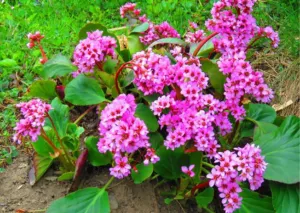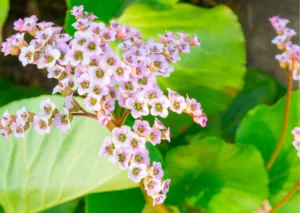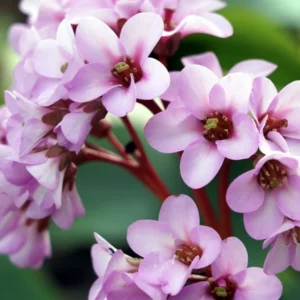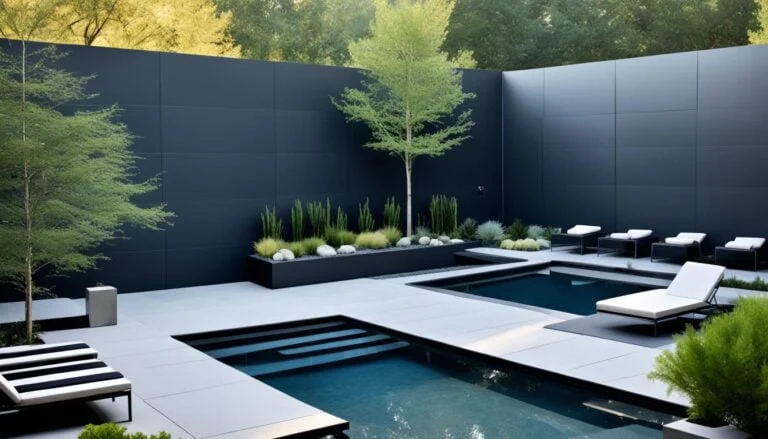Introduction
Outdoor Bergenia, often hailed as a jewel in the garden for its robust nature and striking foliage, is a perennial favorite among gardeners. This detailed review delves into the various aspects of caring for Outdoor Bergenia, offering insights and practical tips to ensure its flourishing growth. We approach this guide with a positive outlook, emphasizing the plant’s resilience and versatility, making it an excellent choice for both novice and experienced gardeners.
we explore everything from basic plant care to more nuanced aspects such as snow survival and propagation. Whether you are a seasoned gardener or a beginner, this comprehensive review will equip you with the knowledge to grow and maintain a healthy Bergenia plant.
The key specifications of Outdoor Bergenia:
| Key Specifications | Details |
|---|---|
| Common Names | Pigsqueak, Elephant’s Ears, Heartleaf Bergenia |
| Botanical Name | Bergenia spp. |
| Family | Saxifragaceae |
| Plant Type | Perennial |
| Mature Size | Typically 12-18 inches tall and wide |
| Sun Exposure | Partial shade to full sun |
| Soil Type | Well-draining, loamy, rich in organic matter |
| Soil pH | Slightly acidic to neutral (pH 5.5 to 7.0) |
| Snow Surviving | Excellent; hardy leaves withstand snow and frost |
| Bloom Time | Spring (sometimes extending into early summer) |
| Flower Color | Pink, purple, white, depending on the variety |
| Hardiness Zones | Typically zones 3 to 8 |
| Native Area | Central Asia, particularly in the Himalayas |
| Benefit | Low maintenance, deer-resistant, attractive foliage and flowers, good groundcover, winter interest |
Provides a quick-reference guide to the key specifications of Outdoor Bergenia. Each aspect, from its common names to its native area, highlights the plant’s unique characteristics and requirements, offering a concise yet comprehensive overview for gardeners and enthusiasts.
Plant Care
Caring for Outdoor Bergenia is a rewarding experience, thanks to its adaptable nature. These plants thrive with minimal fuss, making them ideal for various garden settings. The key to successful Bergenia care lies in understanding its basic needs: adequate sunlight, proper soil conditions, timely watering, and the right temperature and humidity levels. Additionally, periodic pruning and proper overwintering techniques will ensure your Bergenia not only survives but thrives year-round.
Sun Exposure
Bergenia plants prefer partial shade to full sun exposure. They are versatile in their sunlight requirements, making them suitable for a variety of garden locations. However, in areas with intense sun, especially in the afternoon, providing some shade is beneficial. The right balance of sunlight ensures lush foliage and vibrant blooms, enhancing the plant’s overall health and aesthetic appeal.
Soil
The soil for Bergenia should be well-draining yet retain adequate moisture. These plants are not particularly fussy about soil pH, but they perform best in a slightly acidic to neutral range. Amending the soil with organic matter can improve its structure and nutrient content, providing an ideal growing medium for these hardy perennials.
Water
While Bergenia is drought-tolerant once established, regular watering during the growing season is crucial, especially for newly planted specimens. The soil should be kept evenly moist but not waterlogged. Overwatering can lead to root rot, so it’s important to allow the soil to dry out slightly between watering sessions.
Temperature and Humidity
Outdoor Bergenia is remarkably adaptable to various temperature ranges and humidity levels. These plants can thrive in both cool and moderately warm climates. However, they appreciate a certain level of humidity for optimal growth. In very dry conditions, occasional misting or a mulch layer can help maintain adequate moisture levels around the plants.
Snow Surviving
One of the standout features of Bergenia is its ability to survive snow and cold temperatures. The plant’s leathery leaves offer natural protection against frost and snow. In regions with heavy snowfall, Bergenia can be a reliable choice for adding winter interest to the garden.
Pruning
Pruning is an essential aspect of Bergenia care, promoting healthier growth and more abundant blooms. Removing spent flower stalks and dead or damaged leaves keeps the plant looking tidy and can prevent disease. Spring is the ideal time for pruning, as it prepares the plant for the growing season ahead.
Overwintering
In colder climates, overwintering Bergenia requires some attention. Although the plant is cold-hardy, providing a layer of mulch can offer extra insulation during harsh winters. This practice helps to protect the root system and ensures the plant’s vigor in the spring.
Fertilizer
Bergenia benefits from occasional fertilization, especially during the growing season. A balanced, slow-release fertilizer applied in the spring can provide the necessary nutrients for healthy growth and blooming. However, it’s important not to over-fertilize, as this can lead to excessive foliage growth at the expense of flowers.
Propagating Plant
Propagation of Bergenia is a straightforward process, typically done by division. This method not only helps in creating more plants but also rejuvenates older clumps that might have become woody or less vigorous. Spring is the best time for dividing Bergenia, ensuring the new plants have a full growing season ahead.
Types of Outdoor Bergenia Plant
Bergenia species come in various types, each boasting unique characteristics. Some popular varieties include:
- Bergenia cordifolia: Known for its heart-shaped leaves and pink flowers.
- Bergenia crassifolia: Features larger leaves and blooms in shades of pink and white.
- Bergenia purpurascens: Distinguished by its purple-tinted leaves and deep pink flowers.
- Bergenia ‘Bressingham White’: Offers stunning white flowers, a rarity in Bergenias.
- Bergenia ‘Winter Glow’: Renowned for its red winter foliage and pink spring flowers.
Each variety brings its own charm and benefits, making Bergenia a diverse and versatile choice for gardeners.
Common Pests & Plant Diseases with Solutions
Bergenia is relatively hardy, but it can be susceptible to certain pests and diseases:
- Slugs and Snails: These pests are attracted to the fleshy leaves. Solution: Use organic slug pellets or set up beer traps to control their population.
- Crown Rot: Caused by excessive moisture around the roots. Solution: Ensure good drainage and avoid overwatering.
- Leaf Spot: Fungal infections that cause spots on leaves. Solution: Improve air circulation and remove affected leaves. Fungicides can also be used as a preventive measure.
Regular monitoring and maintaining good cultural practices are key to preventing these issues.
How to Get Bergenia to Bloom
To encourage blooming in Bergenia:
- Sunlight: Ensure the plant receives adequate sunlight, as too much shade can reduce flowering.
- Pruning: Remove old flower stalks and dead leaves to direct energy towards new blooms.
- Fertilization: Apply a balanced fertilizer in early spring to provide essential nutrients.
- Watering: Keep the soil moist but not soggy during the growing season.
By providing the right conditions, you can enjoy the beautiful blooms of Bergenia throughout its flowering season.
Common Problems With Bergenia
Despite its hardiness, Bergenia can face a few common problems:
- Leggy Growth: This often occurs due to too much shade. Solution: Move the plant to a sunnier location or prune surrounding vegetation to increase light exposure.
- Scorched Leaves: Can happen in too much direct sunlight. Solution: Provide some afternoon shade, especially in hotter climates.
- Poor Flowering: Often due to inadequate sunlight or over-fertilization. Solution: Ensure proper light conditions and avoid excessive use of high-nitrogen fertilizers.
- Frost Damage: Although frost-hardy, young plants can be susceptible. Solution: Provide a protective mulch layer in winter.
Understanding and addressing these problems promptly will help in maintaining a healthy and vibrant Bergenia plant.
Conclusion: The Resilient Bergenia
Outdoor Bergenia is a testament to both beauty and resilience in the plant world. This guide has explored the various facets of Bergenia care, highlighting its adaptability and relative ease of maintenance. From understanding the ideal growing conditions to tackling common problems, the information provided here serves as a comprehensive resource for anyone looking to add this magnificent plant to their garden. Embracing Bergenia in your outdoor space not only enhances its aesthetic appeal but also adds a touch of hardiness and reliability, making it a worthwhile and satisfying gardening endeavor.
Quickly Declining
Although Bergenia is generally robust, it can sometimes decline rapidly due to factors like overwatering, poor soil conditions, or pest infestations. Early detection and intervention are key to reversing any decline. Regular monitoring and adhering to the plant’s basic care requirements can prevent most issues.
Conclusion: The Resilient Bergenia
Outdoor Bergenia is a resilient and versatile plant that can enhance any garden with its lush foliage and vibrant blooms. With proper care, including appropriate sun exposure, soil conditions, water, and temperature management, this plant can thrive in a variety of settings. Regular pruning and the right overwintering practices further ensure its health and longevity. Whether you are a novice or an experienced gardener, Bergenia is an excellent addition to your garden, offering both beauty and ease of care.
Frequently Asked Questions
Decode the magic of gardens with our guide to Landscaping Styles Frequently Asked Questions.
- Water your Bergenia to keep the soil evenly moist, especially during dry spells. Allow the soil to dry out slightly between watering to prevent root rot.
- While Bergenia prefers partial shade to full sun, it can survive in full shade, though its flowering may be reduced.
- Bergenia does not require frequent fertilization. A slow-release, balanced fertilizer applied in the spring is typically sufficient.
- Propagate Bergenia by division in the spring. This involves splitting the plant into smaller sections, ensuring each section has roots and shoots, and replanting them.
Recent Posts
- Modern Mural Ideas Transforming Walls into Artworks
- Thematic Table Decor Dressing Your Table for Special Occasions
- Festive Lighting Ideas Brightening Your Home for the Holidays
- Biodegradable Decor Materials Choosing Earth-Friendly Options
- Personalized Space Decor Making Your Home Uniquely Yours
- New Year’s Eve Decor Ringing in the New Year in Style
- Transforming Junk into Decor Upcycling at Its Best
- Second-Life Decor Objects Giving Old Items New Purpose
- Unique Decoration Crafting Standout Ideas for Your Home
- Environmentally Friendly Styling Decor with a Conscience











